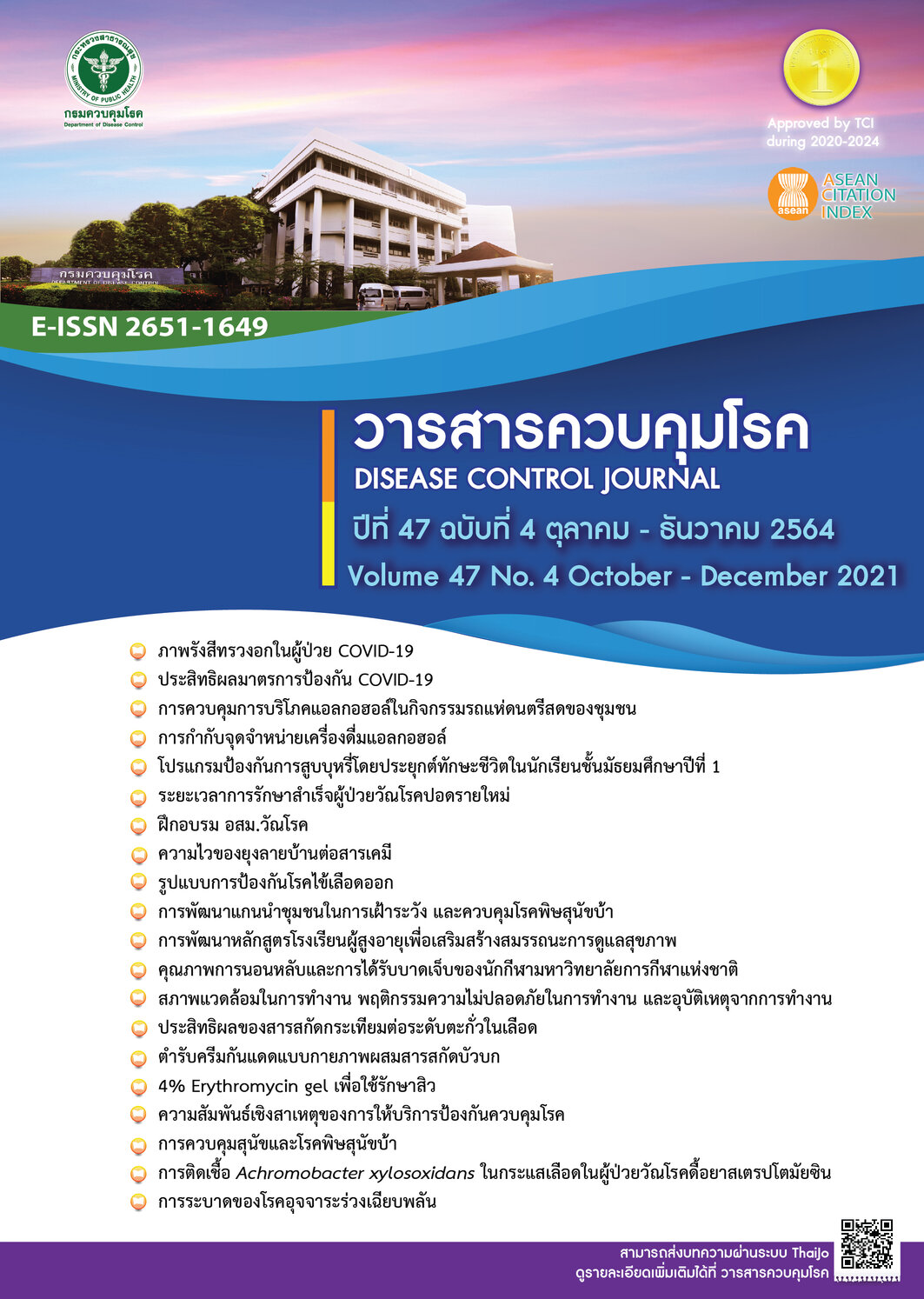Formulation of 4% Erythromycin gel for acne treatment: Assessment of stability and antibacterial activity on acne-causing bacteria
DOI:
https://doi.org/10.14456/dcj.2021.92Keywords:
Erythromycin gel, stability, antibacterial activity, acneAbstract
Objective of this study was to measure the stability of 4% erythromycin gel based on its physical, chemical and microbiological by testing activity against infection such as Staphylococcus aureus, Staphylococcus epidermidis that cause acne. In which 4% erythromycin gel was prepared by using gelling agent hydroxypropyl methylcellulose (HPMC) in term of study in comparing the physical and chemical stability such as pH, color and odor. The stability was compared in varies temperature; 2-8 degree Celsius, room temperature 25 degree Celsius, 45 ±1 degree Celsius and under sunlight in a period of 0, 45 and 90 days. The stability of microbiology is also being tested by testing the activity of antimicrobial S. aureus, S. epidermidis in agar disc diffusion way in order to find zone of inhibition size at 0, 45 and 90 days and found that chemical stability pH remains the same at all conditions. The results shown a changed from the original formula but there were acceptable range between pH 5-8. There were unchanged both of physical and odor stability after 90 days tested. However, the color of sample was turned slight yellow in sample kept under sunlight after 90 days tested. There were significant susceptible to S. aureus and S. epidermidis on day 45 and 90 at room temperature (p-value = 0.076). This study can conclude that 4% erythromycin gel should be keep at temperature or lower than 25 degree Celsius and keep away from sunlight. The further study should be continued over a year and studied in the real environment where patients store the medication.
Downloads
References
Noppakun N, Timpattanapong P, Sinthupak W, Wattanakrai P, Akaraphan R, Suthipaisan N, et al. Clinical Practice Guideline Acne 2010 [Internet]. [cited 2019 Oct 15]. Available from: http:// www.dst.or.th/files_news/Acne_2010.pdf
Allen L, Popovich N, Ansel H. Ointments creams and gels. In Ansel’s Pharmaceutical Dosage Forms and Drug Delivery Systems. 8th ed. New York: Lippincott Williams & Wilkins; 2005.
Malad W, Preechagoon D. Isotretinoin and Clin¬damycin Phosphate Combination Gel Preparation for Acne Treatment: Formulation and Stability Evaluation. IJPS. 2011;7(2):12-21. (in Thai)
Mamah B, Nisan N, Duanyai S, Manok S. Development of cosmetic product from leaves of Moringa oleifera Lam. Collected in Sripoom Community in Thonburi Area. IJPS. 2017;13 (2):80-9. (in Thai)
Lertcanawanichakul M, Tehsuan K, Limvorapan P, Sahoynpong A. Anti-Acne Causing Bacteria Activity of Acne Gel Composed with Biocom¬pounds Produced from Brevibacillus laterospo¬rus. Thaksin University Journal. 2561;3:1-7. (in Thai)
Khunawattanakul W, Caichompoo W, Mekjara¬skul C, Charoenmit A, Lekdee C, Srichan N. Anti-Propionibacterium acnes from Thai herbal medicines. J Sci Technol MSU. 2018;36:607- 13. (in Thai)
Bajaj S, Singla D, Sakhuja N. Stability testing of Pharmaceutical Products. Journal of Applied Pharmaceutical Science. 2012;3:129-38.
Brayfield A. Martindale The Extra Pharmaco¬poeia. 38th ed. London: Pharmaceutical Press; 2014.
Pochanakom K, Buranaosot J. Pharmaceutical Chemistry of Antibiotics: Macrolides. Thai Bul¬letin of Pharmaceutical Sciences. 2004;1:65- 74. (in Thai)
Dupont W, Plummer W. Power and Sample Size Calculations: A Review and Computer Program. Controlled Clinical Trials. 1990;11(2):116-28.
Kadam P, Bhalerao S. Sample size calculation. Int J Ayurveda. 2010;1(1):55-7.
Lertcanawanichakul M, Tehsuan K, Limvorapan P, Sahoynpong A. Anti-Acne Causing Bacteria Activity of Acne Gel Composed with Biocom¬pounds Produced from Brevibacillus laterospo¬rus. Thaksin University Journal. 2018;21(3):1- 7. (in Thai)
Downloads
Published
How to Cite
Issue
Section
License
Articles published in the Disease Control Journal are considered as academic work, research or analysis of the personal opinion of the authors, not the opinion of the Thailand Department of Disease Control or editorial team. The authors must be responsible for their articles.






